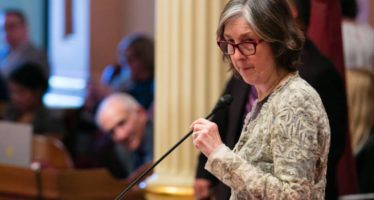Rail plan's unanswered questions
APRIL 5, 2010
By LARRY GILBERT
Assessing the California High Speed Rail Authority (CHSRA) bullet train is reminiscent of the U.S. Senate vote on the national health care legislation where senators were voting before having all the facts. Last November, prior to the public having access to CHSRA’s long delayed Business Plan, 52 percent of California Voters approved Measure 1A, a $9.95 billion Bond Measure for a future 800 mile high-speed rail system. While no one can predict California’s budget status over the next decade, as of now we are facing a $20 billion shortfall for 2010. According to the Legislative Analyst’s Office, once the General Obligation Bonds are sold “we will have to start repaying $647 million per year” during a period of deep budget cuts and mandated furloughs.
The total project cost of Phase 1 of this rail system, with service from San Francisco to Los Angeles/Anaheim, originally pegged at $33.6 billion dollars, is now estimated at $42.6 billion in time of construction costs. The Reason Foundation projects the total system to actually cost between $65 billion and $81 billion.
Phase 2 extensions to Sacramento and San Diego are contingent on finding additional funds. Projected ridership numbers have also been dramatically altered as reported below.
As an update, here is the following project schedule as found in CHSRA’s December 2009 Business Plan: “[B]egin completing environmental reviews in 2011, enter construction in 2012, begin opening sections for passenger service 2017 or earlier, complete the initial system from Anaheim to San Francisco by 2020.”
In CHSRA’s promotional materials, its financial strategy relied on three sources of revenue: State and local funding, federal funding and the private sector, which we know as a “P3” Public, Private, Partnership. The public was told that the federal government would provide 25 percent to 33 percent of the construction costs ($10 billion to $12 billion dollars). Note: While the December 2009 Fact Sheet indicates federal funding increased to $17 billion to $19 billion, there is no way for the public to verify that optimistic sum.
While President Barack Obama is advocating high speed rail to reduce greenhouse gas emissions, and has designated a total of $8 billion in federal stimulus funds for all 50 states, we do not know how much will be awarded to California nor if this is a one-time or annual amount. Above and beyond construction, equipment and eminent domain costs are other key areas to evaluate starting with ridership and fares which have a direct impact on annual subsidies, future profits and, most important, private sector interest.
At the same time, we should not overlook the challenge of compliance with the mandated social engineering found in SB375 to reduce vehicle miles traveled on an annual basis. This California legislative effort to reduce greenhouse gas emissions is pressuring our cities to engage in Smart Growth-oriented, high density development, land use and transportation plans as the carrot to access related federal funding.
In CHSRA’s promotion of this ambitious project voters were told that the cost of a one way ticket for travel between San Francisco and Los Angeles was to be $55. As recently as a Feb 24, 2009 interview with Board Member Quentin Kopp, the public was again told that, “A trip from San Francisco to Los Angeles, which is about 410, 420 miles, will take two hours and 38 minutes with a one-way fare of $55. That’s about half to one-third the cost of a plane ticket for a comparable trip.”
Their latest one-way fares for the same trip in 2008 dollars, has increased to $68-$104 (50 percent-77 percent airfare fee structure), which rail supporters acknowledge reduces projected ridership.
One month before the Nov 2008 election the Bay Area Council Economic Institute’s “California High-Speed Rail” report stated that “at least 88 million passengers are projected to ride the high-speed train annually by 2030.” The CHSRA previously projected 55 million passengers by 2030 yet have reduced that total to 41 million in 2035. Whose projection are we to believe?
This ridership reduction presents a conflict of interest for CHSRA. What’s its goal? Increase private sector profits and reduce subsidies by raising fares or, get us out of our cars? What about their overall goal to reduce carbon dioxide emissions and traffic congestion?
Speaking of our cars. Just as the close passage of Prop 1A differed from high population counties like Los Angeles or San Francisco versus Orange County and other suburban counties, there is a major difference between those living in LA who can grab a bus or subway to a high speed station versus those who live in the suburbs who simply prefer using our cars.
CHSRA has just provided an optimistic project schedule. This project will be delayed until the authority can satisfy Section 2704.04 of Prop 1A/AB 3034, where it must submit to the director of finance and chairperson of the Joint Legislative Budget Committee the source and timing of all funds to be used for each corridor or segment.
Quoting from Samuel Staley, director of urban growth and land use policy at Reason Foundation.: “Ultimately, high-speed rail’s impacts on American travel patterns and employment productivity are going to be negligible, and the actual job creation potential for high-speed rail is much more modest than proponents admit.”
While the CA High-Speed Train Project Ridership and Revenue Forecast report reads that “in the year 2000, more than half a billion trips were made among California’s regions, 95 percent by car” we have neglected our transportation infrastructure.
In the Dec. 22 Orange County Register, Sacramento Bee columnist Dan Walters reports, “California is falling nearly $11 billion a year short on rehabilitating and maintaining it’s highways, bridges and public transportation systems.”
It’s unlikely that this rail project will do much to reduce the state’s overall level of congestion.
Related Articles
Assembly GOP Leader Kristin Olsen introduces new stars
2014 was a solid year for California Republicans. In the state Senate, the GOP prevented Democrats from regaining a two-thirds supermajority. And
California Senate bringing in outside firms to investigate sexual harassment allegations
Senate President Pro Tem Kevin de León, D-Los Angeles, announced on Tuesday that the state Senate will hire outside firms to
MADD angry at ridesharing regulations
Does ridesharing cut down on drunk driving? Mothers Against Drunk Driving says yes. MADD has entered California’s heated debate over new




